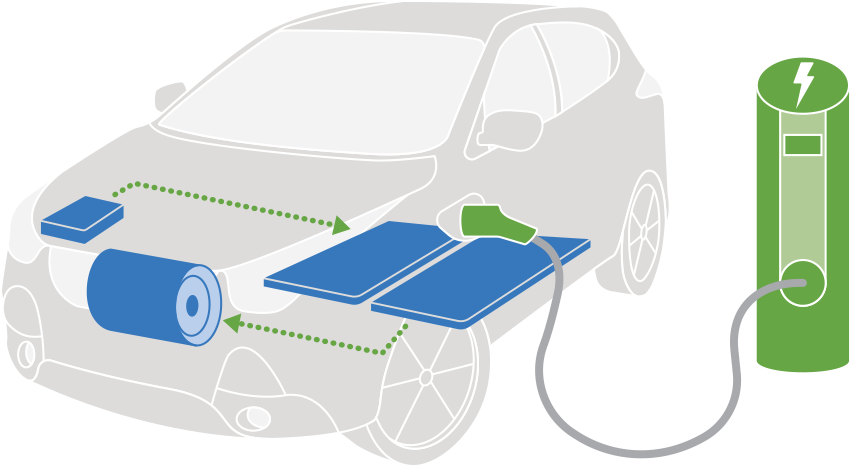
In today’s era of heightened focus on environmental sustainability, the rise of electric vehicles heralds a revolutionary transformation in the automotive industry. To truly grasp the allure of electric cars, it’s essential to delve into how they operate. From the simple act of plugging in for a charge to the intricacies of electric motor systems, the working principles of electric vehicles harbor many sophisticated and captivating technologies. In the following discussion, we’ll explore how electric cars work, from their fundamental principles to charging methods, their distinctive features and components, and address some frequently asked questions. Let’s uncover the mysteries of electric vehicles together, and delve into this captivating frontier of emerging technology.
The Working Principle of Electric Cars
Electric cars operate on the principle of utilizing electrical energy stored in batteries to power an electric motor, which in turn drives the vehicle’s wheels. Unlike traditional internal combustion engine vehicles, which rely on burning fuel to generate power, electric cars are powered by electricity. This electricity can come from a variety of sources, including renewable energy such as solar or wind power, making electric cars a key component of efforts to reduce greenhouse gas emissions and combat climate change.
Mechanism of Electric Motors
Electric motors in electric cars function by converting electrical energy into mechanical energy through electromagnetic induction. When electric current flows through the motor’s coils, it creates a magnetic field that interacts with the magnetic field produced by permanent magnets or electromagnets. This interaction causes the motor’s rotor to rotate, thus propelling the vehicle forward. Electric motors are highly efficient and offer instant torque, providing smooth and responsive acceleration.
How Charging Works?

Charging an electric car involves replenishing the energy stored in its battery pack. This can be done through various methods, including home charging, public charging stations, and fast charging. Home charging is the most convenient option for many electric car owners, as it allows them to plug in their vehicle overnight and wake up to a fully charged battery in the morning. Public charging stations are located in various locations such as parking lots, shopping centers, and along highways, providing opportunities to charge while away from home. Fast charging stations, also known as DC fast chargers, can charge the battery to a significant level in a relatively short time, typically around 30 minutes to an hour, making them ideal for long-distance travel.
Key Features and Components of Fully Electric Cars
Fully electric cars, also known as Battery Electric Vehicles (BEVs), feature several distinct components that enable their operation:
- Battery Pack: The battery pack is the heart of an electric car, storing electrical energy and powering the electric motor. It is usually located underneath the car’s floor to optimize space and weight distribution.
- Electric Motor: The electric motor converts electrical energy from the battery into mechanical energy to drive the vehicle. Electric motors are compact, lightweight, and highly efficient, making them ideal for powering electric cars.
- Power Electronics: Power electronics components such as inverters and converters control the flow of electricity between the battery and the motor, ensuring efficient operation and optimal performance.
- Charging Port: The charging port provides an interface for connecting the car to an external power source for charging. It may be located on the front fender, rear bumper, or hidden behind a panel for aesthetic purposes.
- Regenerative Braking System: Electric cars often feature regenerative braking systems, which recapture energy during braking and convert it into electrical energy to recharge the battery. This helps improve overall efficiency and extend the vehicle’s range.
Notable Features of Electric Cars
Electric cars offer several advantages over traditional vehicles, including:
- Zero Emissions: Electric cars produce no tailpipe emissions, contributing to cleaner air and reduced environmental impact. This is particularly significant in urban areas where air quality is a concern.
- Lower Operating Costs: Electricity is often cheaper than gasoline, resulting in lower fueling costs for electric car owners. Additionally, electric cars have fewer moving parts and require less maintenance than traditional vehicles, further reducing operating costs over the vehicle’s lifetime.
- Quiet Operation: Electric motors operate more quietly than internal combustion engines, providing a quieter driving experience and reducing noise pollution in urban environments.
- Instant Torque: Electric motors deliver instantaneous torque, resulting in swift acceleration and responsive performance. This provides a dynamic driving experience and enhances overall vehicle agility.
Frequently Asked Questions and Answers
Q: How long does it take to charge an electric car?
A: Charging times vary depending on the charging method and the car’s battery capacity. Home charging typically takes several hours, while fast charging can replenish a significant portion of the battery’s charge in a shorter time.
Q: What is the range of an electric car?
A: The range of an electric car refers to the distance it can travel on a single charge. It varies between models but generally ranges from around 100 to over 300 miles on a full charge.
Q: Are electric cars more expensive to maintain?
A: Electric cars often have fewer moving parts and require less maintenance than traditional vehicles. However, battery replacement can be a significant expense, although advancements in battery technology are reducing costs over time.
By understanding the working principles, components, and features of electric cars, individuals can make informed decisions about adopting this sustainable and innovative mode of transportation. As technology continues to evolve and infrastructure improves, electric cars are poised to play an increasingly important role in shaping the future of mobility.